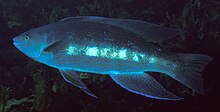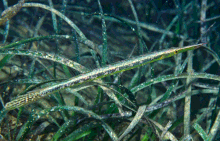Hypsigenyini
| Hypsigenyini | |
|---|---|

| |
| Hogfish (Lachnolaimus maximus) | |

| |
| Greenbone (Odax pullus) | |
| Scientific classification | |
| Domain: | Eukaryota |
| Kingdom: | Animalia |
| Phylum: | Chordata |
| Class: | Actinopterygii |
| Order: | Labriformes |
| Family: | Labridae |
| Tribe: | Hypsigenyini Gomon (1997) |
| Genera | |
|
15-17, see text | |
The hypsigenyine wrasses are saltwater fish of the tribe Hypsigenyini, a subgroup of the wrasse family (Labridae). The group is circumglobal, being found in almost all the of world's shallow tropical marine waters, although some species are also found in temperate zones.[1]
Taxonomy
[edit]Hypsigenyini is the sister group to all other wrasse tribes. The group was first proposed in 1997. Since then, molecular phylogenetics has found that it also includes odacines and the genus Pseudodax. Odacines were once considered to be their own taxonomic family, but have been found nested deep within the hypsigenyine wrasses, and are the sister group to the hypsigenyine genus Choerodon.[1][2] Odacines remain a monophyletic group however.[2][3] Pseudodax was once considered to be the closest relative to parrotfish (tribe Scarini), but is now considered a basal hypsigenyine.[1]
Westneat & Alfaro (2005) and Hughes et al (2022) found that the hogfish (Lachnolaimus maximus) is the sister group to all other hypsigenyine wrasses. However, neither study examined the natal wrasse (Anchichoerops natalensis),[1][2] which was recovered as the actual sister group to all other hypsigenyine wrasses by Balwin et al (2023).[4]

Hypsigenyine wrasses exhibit several ancestral features shared with perciforms, but were subsequently lost in more derived wrasses. One example is the presence of vomerine teeth.[1] Hypsigenyine wrasses also have a derived trait, which is phyllodont dentition of the pharyngeal teeth, ie, these teeth develop stacked on top of each other, with only the uppermost teeth in the stack emerging.[5] The Italian fossil wrasse †Phyllopharyngodon is strongly supported to be a hypsigenyine because it features such teeth,[5] and is about 50 million years old, dating to the Eocene.[1]
Genera
[edit]| Genus | Image | |
|---|---|---|
| Achoerodus T. N. Gill, 1863 | 
| |
| Anchichoerops Barnard, 1927 | ||
| Bodianus Bloch, 1790 | 
| |
| Choerodon Bleeker, 1840 | 
| |
| Decodon Günther, 1861 | 
| |
| Lachnolaimus G. Cuvier, 1829 | 
| |
| Polylepion M. F. Gomon, 1977 | 
| |
| Pseudodax Bleeker, 1861 | 
| |
| Terelabrus J. E. Randall & Fourmanoir, 1998 | 
| |
| Odacine
clade |
Haletta Whitley, 1947 | 
|
| Heteroscarus Castelnau, 1872 | 
| |
| Neoodax Castelnau, 1875 | 
| |
| Odax Valenciennes, 1840 | 
| |
| Parodax Scott, 1976 | ||
| Olisthops Richardson, 1850 | 
| |
| Sheardichthys Whitley, 1947 | 
| |
| Siphonognathus Richardson, 1858 | 
| |
References
[edit]- ^ a b c d e f Westneat, Mark W.; Alfaro, Michael E. (August 2005). "Phylogenetic relationships and evolutionary history of the reef fish family Labridae". Molecular Phylogenetics and Evolution. 36 (2): 370–390. doi:10.1016/j.ympev.2005.02.001.
- ^ a b c Hughes, Lily C; Nash, Chloe M; White, William T; Westneat, Mark W (2023-05-01). "Concordance and Discordance in the Phylogenomics of the Wrasses and Parrotfishes (Teleostei: Labridae)". Systematic Biology. 72 (3): 530–543. doi:10.1093/sysbio/syac072. ISSN 1063-5157.
- ^ Clements, Kendall D; Alfaro, Michael E; Fessler, Jennifer L; Westneat, Mark W (August 2004). "Relationships of the temperate Australasian labrid fish tribe Odacini (Perciformes; Teleostei)". Molecular Phylogenetics and Evolution. 32 (2): 575–587. doi:10.1016/j.ympev.2004.02.003.
- ^ Baldwin, Carole C.; Arcila, Dahiana; Robertson, D. Ross; Tornabene, Luke (2023-04-13). "Description of the First Species of Polylepion (Teleostei: Labridae) from the Atlantic Ocean with Analysis of Evolutionary Relationships of the New Species". Ichthyology & Herpetology. 111 (2). doi:10.1643/i2022075. ISSN 2766-1512.
- ^ a b Bellwood, David R.; Schultz, Ortwin; Siqueira, Alexandre C.; Cowman, Peter F. (2019). "A review of the fossil record of the Labridae". Annalen des Naturhistorischen Museums in Wien. Serie A für Mineralogie und Petrographie, Geologie und Paläontologie, Anthropologie und Prähistorie. 121: 125–194. ISSN 0255-0091.
